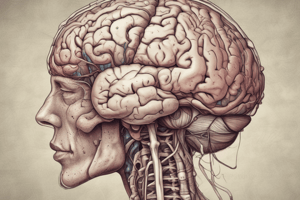Podcast
Questions and Answers
What structures make up the brainstem?
What structures make up the brainstem?
medulla and pons
What is the function of the thalamus?
What is the function of the thalamus?
- Coordinates sleep
- Controls voluntary movement
- Acts as the brain's sensory control center (correct)
- Regulates heartbeat and breathing
What is the function of the reticular formation?
What is the function of the reticular formation?
Controls arousal
What is the cerebellum responsible for?
What is the cerebellum responsible for?
The ______________ is a crossover point where nerves from the left side of the brain are mostly linked to the right side of the body, and vice versa.
The ______________ is a crossover point where nerves from the left side of the brain are mostly linked to the right side of the body, and vice versa.
What did James Olds and Peter Milner accidentally discover when trying to implant an electrode in a rat's reticular formation?
What did James Olds and Peter Milner accidentally discover when trying to implant an electrode in a rat's reticular formation?
What do researchers refer to instead of 'pleasure centers' in today's context?
What do researchers refer to instead of 'pleasure centers' in today's context?
How often would rats self-stimulate the reward centers in their brain per hour?
How often would rats self-stimulate the reward centers in their brain per hour?
Humans have limbic centers for pleasure.
Humans have limbic centers for pleasure.
The _________ helps process for storage explicit memories of facts and events.
The _________ helps process for storage explicit memories of facts and events.
Flashcards are hidden until you start studying
Study Notes
Older Brain Structures
- The brain's oldest and innermost region is the brainstem, which is responsible for automatic survival functions such as:
- Heartbeat control
- Breathing control
- Sleep control
- Movement coordination
- The brainstem is divided into two parts:
- Medulla: the base of the brainstem, which controls heartbeat and breathing
- Pons: the part of the brainstem that helps coordinate movements and control sleep
The Thalamus
- The thalamus is a pair of egg-shaped structures that act as the brain's sensory control center, receiving information from all senses except smell
- The thalamus routes sensory information to higher brain regions and receives some of the higher brain's replies
- It is compared to London's Heathrow Airport, where traffic flows in and out on its way to various locations
The Reticular Formation
- The reticular formation is a nerve network that travels through the brainstem into the thalamus
- It filters incoming stimuli and relays important information to other brain areas
- It is also involved in controlling arousal and plays a crucial role in multitasking
The Cerebellum
- The cerebellum is a baseball-sized structure located at the rear of the brainstem, which is involved in:
- Nonverbal learning and skill memory
- Judging time and modulating emotions
- Discriminating sounds and textures
- Coordinating voluntary movements
- The cerebellum is also involved in balance and coordination, and damage to it can lead to difficulties in walking, keeping balance, or performing fine motor skills
The Limbic System
- The limbic system is a neural system located below the cerebral hemispheres, which is associated with emotions and drives
- It consists of three key structures:
- Amygdala: involved in aggression and fear
- Hypothalamus: involved in various bodily maintenance functions, such as hunger, thirst, and body temperature
- Hippocampus: involved in processing conscious, explicit memories of facts and events
The Amygdala
- The amygdala is a structure involved in emotions, particularly fear and aggression
- Research has shown that damage to the amygdala can reduce aggression and fear responses
- Electrical stimulation of the amygdala can provoke angry reactions
The Hypothalamus
- The hypothalamus is a neural structure involved in various bodily maintenance functions, such as:
- Hunger regulation
- Thirst regulation
- Body temperature regulation
- Sexual behavior
- It is also involved in emotion and reward processing
The Hippocampus
- The hippocampus is a structure involved in processing conscious, explicit memories of facts and events
- Damage to the hippocampus can lead to difficulties in forming new memories
- The hippocampus decreases in size and function as we grow older
Studying That Suits You
Use AI to generate personalized quizzes and flashcards to suit your learning preferences.




